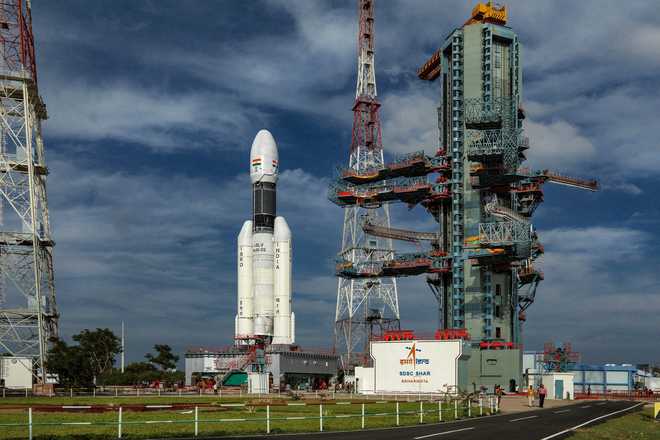
A view of ISRO''s GSLV-MkIII D2 mission carrying high throughput communication satellite GSAT-29 set to be launched from the second launch pad in the spaceport, in Sriharikota on Tuesday, November 13, 2018. ISRO photo via PTI
Chennai, November 13
The 27-hour countdown began on Tuesday for the launch of India's latest communication satellite GSAT-29 onboard the second developmental flight GSLV-MkII D2 from the spaceport of Sriharikota Wednesday evening, subject to weather conditions, the ISRO said.
Though cyclone "Gaja", earlier forecast to cross the coast between Chennai and Sriharikota, has changed course, the Indian Space Research Organisation said the launch slated for 5.08 pm was subject to the weather and it may go for postponement in case of non-conducive conditions.
GSAT-29 carries Ka and Ku band high throughput transponders intended to meet the communication requirements of users, including in the North East and in Jammu and Kashmir.
"The countdown has begun today 14:50 hrs for the launch of GSLVMkIII D2 carrying GSAT29 at Sriharikota (over 100 km from here). Launch scheduled at 17.08 IST on November 14", ISRO said.
ISRO Chairman K Sivan said there might by a postponement if the weather was not conducive.
"But we are expecting that the launch will happen by tomorrow evening", he told reporters after offering prayers at the famous hill shrine of Lord Venkateswara at Tirumala, about 140 om from here, on the eve of the mission.
On November 11, the Met office had said Cyclone Gaja was likely to cross the North Tamil Nadu and South Andhra Pradesh coast between Cuddalore and Sriharikota on November 15.
However, the cyclone has changed course and as of Tuesday was expected to cross the Tamil Nadu coast between Cuddalore and Pamban, well away from Sriharikota.
The ISRO chief said the Wednesday launch was one of the "very important missions and a milestone" for India's space programme.
"This is GSLV-MkIII-D2 second developmental flight. It is going to launch very important and high throughput satellite GSAT-29. The satellite will be useful in Jammu and Kashmir and North East region for providing connectivity under the Centre's Digital India programme", he said.
A successful launch would pave the way for producing very advanced satellite in future for ISRO, he said.
"(It is) This vehicle (GSLV-MkIII) is going to launch the Chandrayaan-II and also the manned mission. We are getting prepared for that. If everything goes normal, lift off will happen at around 5pm and 8 minutes (tomorrow)", he said.
Following the lift off, the rocket would inject the satellite into the Geostationary Transfer Orbit (GTO) with required inclination to the equator.
The satellite would be placed in its final Geostationary Orbit using the on-board propulsion system and it may take a few days after separation from launcher to reach the orbital slot, ISRO said.
GSLV-MkIII is the fifth generation launch vehicle developed by ISRO and is designed to place satellites of upto 4,000 kg in GTO.
The launch vehicle is the 67th launch mission from the Satish Dhawan Space Centre at Sriharikota and the 33 communication satellite built by ISRO for which this will be be the fifth launch this year.
The GSLV-MkIII-D2 is a three stage launch vehicle with two solid strap-ons, a liquid core stage and a cryogenic upper stage.Compared to solid and liquid stages, the C25 cryogenic stage is more efficient as well as complex.
According to the ISRO, the GSAT-29 satellite is intended to serve as a test bed for several new technologies. It is specifically designed to cater to communication requirements of users from remote areas of the country.
Around 16 min 43 seconds the GSAT-29 separation is expected to take place after the launch. The mission life is about 10 years. - PTI



























